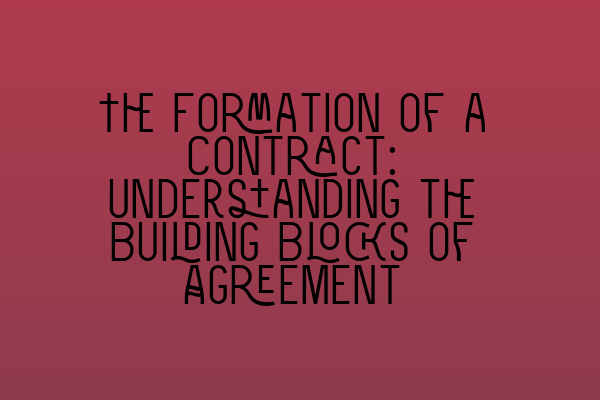The Formation of a Contract: Understanding the Building Blocks of Agreement
Welcome to our blog post on the formation of a contract. In this article, we will delve into the fundamental elements that make up a legally binding agreement. Whether you are a law student preparing for the SQE exam or a legal professional looking to refresh your knowledge, this article will provide you with a comprehensive understanding of contract formation.
Before we dive into the intricacies, it is important to establish a basic definition of a contract. A contract is a legally enforceable agreement between two or more parties, in which they agree to undertake certain obligations and responsibilities. Now, let’s explore the essential building blocks that constitute a contract.
1. Offer and Acceptance:
The first step in forming a contract is the creation of an offer. An offer is a proposal made by one party to another, expressing a willingness to enter into a contract under specified terms. The offer must be clear, definite, and communicated to the offeree. Once the offer is made, the offeree has the option to accept or reject it. If the offeree accepts the offer without any modifications, a binding contract is formed.
2. Consideration:
Consideration is a crucial element of contract formation. It refers to something of value exchanged between the parties to the contract. Each party must provide consideration to the other, which can be in the form of money, goods, services, or a promise to do or refrain from doing something. Consideration ensures that both parties have a mutual obligation and prevents contracts based on mere gratuitous promises.
3. Intention to Create Legal Relations:
For a contract to be enforceable, there must be an intention on the part of the parties to create legal relations. This means that the parties must intend to be legally bound by the terms of the contract. This intention can be inferred from the circumstances surrounding the agreement. Contracts between family members or friends are generally presumed to be non-binding unless they clearly indicate otherwise.
4. Capacity to Contract:
Another essential element of contract formation is the capacity to contract. This refers to the legal ability of the parties to enter into a contract. In general, parties must have reached the legal age of majority and possess sound mind to be considered capable of contracting. Individuals who are under the influence of drugs or alcohol, mentally incapacitated, or minors may lack the capacity to enter into a binding contract.
5. Legal Formalities:
While most contracts do not require any specific formality, certain types of contracts must meet specific formal requirements. For example, contracts for the sale of land usually require written documentation to be enforceable. Additionally, certain contracts may require the involvement of a witness or be executed under seal. It is essential to understand the legal formalities associated with the specific type of contract being formed.
By understanding these fundamental elements, you can navigate the complexities of contract formation with ease. Whether you are drafting, negotiating, or analyzing a contract, a solid grasp of these building blocks will enable you to identify and address any issues that may arise.
To further enhance your understanding of contract law and prepare for the SQE exam, we recommend exploring the following related articles:
– SQE Sample Papers: Practice for Exam Success
– Adjusting Your SQE Strategy Based on Mock Performance
– Peer Discussions Post-Mock: Learning from Collaboration and Feedback
– Adjusting Strategy Based on Mock Performance: Improving Your Approach
– Strengthening Weak Areas in SQE: Targeted Practice for Improvement
These articles provide valuable insights and strategies to excel in your SQE preparation and enhance your understanding of contract law. Remember, knowledge is the key to success in the legal field, and continuous learning and practice are essential for professional growth and excellence.
In conclusion, understanding the formation of a contract is vital for anyone involved in contract law. By grasping the elements of offer and acceptance, consideration, intention to create legal relations, capacity to contract, and legal formalities, you will be well-equipped to navigate the complexities of contract formation. Continuously honing your knowledge and skills through practice and learning will ensure your success in the legal profession.
That’s it for this blog post on the formation of a contract. Stay tuned for more insightful articles and resources to support your legal journey.
